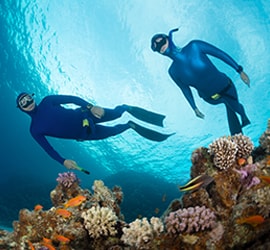
Barracuda Point
True abundance of marine life
As I dived for the very first time in the lagoon of New Caledonia, at Duck Island, with only my mask and my fins, I quickly recognised something I had not seen in a while: a healthy coral reef! My first scuba dives in the north of the main island, in Koumac, a week later were a festival of colours and shapes along densely covered walls.
I wonder why the lagoon of New Caledonia remains rather unknown internationally while it beats many records:
- a total surface area of more than 40,000km² making it the largest lagoon in the world.
- a coral reef stretching over 1,600km, the 2nd largest barrier reef in the world after the Great Barrier Reef of Australia which is 2,300km long and not Belize as often mentioned, which is only 300km long, even if we count the Meso-American barrier reef, which goes from Mexico to Honduras over 1,000km.
- more than 20,000 marine and plant species, including protected species such as dugongs, sea turtles and humpback whales, an exceptionally high number of coastal fish species (1,764 species were listed, it is much more than the rest of the Pacific, especially compared to Hawaii or French Polynesia), and 400 coral species.



